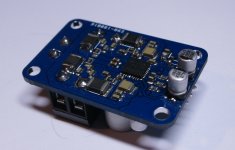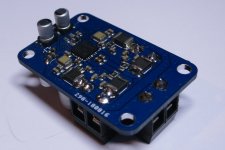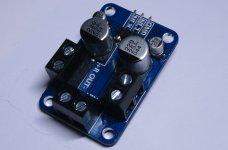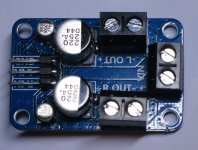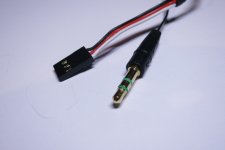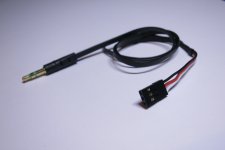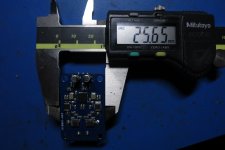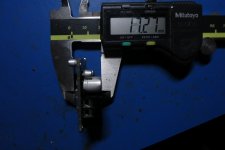This is my first post here other than the introduction, so hi )
So earlier this year, a friend of mine had a cheap class D amp from ebay and it broke (turns out the battery wasn't charged...). He was pretty fed up with cheap ebay stuff so he asked me if I could build a better one.
A browse through TI and I settled on the TPA3132. This is basically the same as the TPA3116 (I think) but in a QFN package. The first set of boards were 1.5x2.5" in size and were just the datasheet schematic. I was completely lazy and just stuck everything in one ground plane and didn't pay much attention to the layout.
So we built a few of the boards and even with the sloppy layout they sounded MUCH better than the ebay ones, and were already much smaller. He had paid for all the parts so he took the boards and left me one to play with. I gradually cut the thing up and tried different components to improve it as one of my projects on the side.
Fast forwarding to now, I've completed the assembly of a new amp, which measures 1.5x1", by about 3/4" high when populated, uses the TPA3132 with ferrite bead output filters, has far more responsible use of ground planes among other improvements. I also shoehorned screw terminals and connectors onto it, so it can be used with no soldering. BTW the input is single ended, as the idea of this thing is just to be plugged into a phone or something.
By comparison to my composite LM3886 amp, the difference in sound quality is only just noticeable (to my ears). It doesn't affect any of my FM radios whatsoever, but obviously still radiates (depends mostly on speaker wire length). It also barely gets warm when running on max volume. Works great off a laptop power brick, or a battery if you want a portable set of speakers.
As for the specs, the gain is 32dB with an input impedance of 15K. The output power is 2x25W(8Ω) 2x50W(4Ω), and it runs on anything between 4.5V-22V.
I realise not everyone needs such a small amp, but I've built 10 so I'll keep one for me and sell 9, if anyone is interested. Would be perfect for a set of portable speakers. Note that they are hand assembled, so some of the boards have a bit of excess flux etc... on the non-reflowed components, but all work well. I've made up 500mm long 3.5mm jack to the 3-way female header sockets to mate with the amp. I couldn't fit a normal jack socket on the board as I ran out of room.
Anyway this thread isn't just trying to sell these things, any and all questions/criticisms are welcomed. But if you are interested in one, let me know.
(Reading it back it looks like I have something against items from ebay, what I mean is cheap crap from ebay 🙂 )
Edit: All boards now gone. Also posted on EEVblog so they went very fast. Thanks for all the interest. I'm now working on a new version (building another 10 of them) with full LC output filters and some other minor changes.
So earlier this year, a friend of mine had a cheap class D amp from ebay and it broke (turns out the battery wasn't charged...). He was pretty fed up with cheap ebay stuff so he asked me if I could build a better one.
A browse through TI and I settled on the TPA3132. This is basically the same as the TPA3116 (I think) but in a QFN package. The first set of boards were 1.5x2.5" in size and were just the datasheet schematic. I was completely lazy and just stuck everything in one ground plane and didn't pay much attention to the layout.
So we built a few of the boards and even with the sloppy layout they sounded MUCH better than the ebay ones, and were already much smaller. He had paid for all the parts so he took the boards and left me one to play with. I gradually cut the thing up and tried different components to improve it as one of my projects on the side.
Fast forwarding to now, I've completed the assembly of a new amp, which measures 1.5x1", by about 3/4" high when populated, uses the TPA3132 with ferrite bead output filters, has far more responsible use of ground planes among other improvements. I also shoehorned screw terminals and connectors onto it, so it can be used with no soldering. BTW the input is single ended, as the idea of this thing is just to be plugged into a phone or something.
By comparison to my composite LM3886 amp, the difference in sound quality is only just noticeable (to my ears). It doesn't affect any of my FM radios whatsoever, but obviously still radiates (depends mostly on speaker wire length). It also barely gets warm when running on max volume. Works great off a laptop power brick, or a battery if you want a portable set of speakers.
As for the specs, the gain is 32dB with an input impedance of 15K. The output power is 2x25W(8Ω) 2x50W(4Ω), and it runs on anything between 4.5V-22V.
I realise not everyone needs such a small amp, but I've built 10 so I'll keep one for me and sell 9, if anyone is interested. Would be perfect for a set of portable speakers. Note that they are hand assembled, so some of the boards have a bit of excess flux etc... on the non-reflowed components, but all work well. I've made up 500mm long 3.5mm jack to the 3-way female header sockets to mate with the amp. I couldn't fit a normal jack socket on the board as I ran out of room.
Anyway this thread isn't just trying to sell these things, any and all questions/criticisms are welcomed. But if you are interested in one, let me know.
(Reading it back it looks like I have something against items from ebay, what I mean is cheap crap from ebay 🙂 )
Edit: All boards now gone. Also posted on EEVblog so they went very fast. Thanks for all the interest. I'm now working on a new version (building another 10 of them) with full LC output filters and some other minor changes.
Attachments
Last edited:
What are the physical dimensions in real numbers (metric)? Inches typically swing between 24mm and 28mm.
Last edited:
I always thought an inch was 25.4mm. I design my boards in imperial as that's pretty much the standard for board design, although things are changing a bit now.
With the callipers, the dimensions (rounded to 1mm) are 26Wx38Lx18Hmm.
With the callipers, the dimensions (rounded to 1mm) are 26Wx38Lx18Hmm.
I ought to add that one of the biggest improvements in sound quality was separating the AVCC and PVCC supplies. On the old boards the analogue supply was tied right to the power supply pins. On the one I played with I cut the trace and put the analogue supply through a ferrite bead and added extra decoupling for it. So I incorporated it here.
Note that there is a footprint for a SOT-23-6 package on the board. This is because I had the bright idea of supplying the analogue through a separate 5V reg. I only tested this on an old board after I had sent off the gerbers for the new ones. The AVCC and PVCC inputs need to be within about 0.5V of each other, or the output develops serious noise.
Note that there is a footprint for a SOT-23-6 package on the board. This is because I had the bright idea of supplying the analogue through a separate 5V reg. I only tested this on an old board after I had sent off the gerbers for the new ones. The AVCC and PVCC inputs need to be within about 0.5V of each other, or the output develops serious noise.
That means it's almost exactly the same size as the old amp32 from 41hz (slightly larger height but only by 2mm). The important thing is the width. It cannot be more than 26mm, not even by 0.1mm, if people are to use them as replacements for the amp32. If that's the case I might know some people that'll take them of your hands pretty quick.
Thanks for the information. I've included some photos for you, those are nice calibrated callipers so that's spot on.
In hindsight I should have put those two electrolytics on the other side of the board, that would have shaved nearly 6mm off the height. But that's fairly easy and can be done in the next revision.
In hindsight I should have put those two electrolytics on the other side of the board, that would have shaved nearly 6mm off the height. But that's fairly easy and can be done in the next revision.
Attachments
I have two claimed, that's all the ones I have built so far. I've just ordered amp chips to finish the rest, they will be here next week and I can finish the rest.
If there is demand, or if anyone thinks there might be, please let me know and I can get another batch built ASAP so no one has to wait.
If there is demand, or if anyone thinks there might be, please let me know and I can get another batch built ASAP so no one has to wait.
... TPA3132 with ferrite bead output filters...
Short speaker wires ...
...
There is NO such thing as a filterless class D even these low power devices rely on the speaker/headphone coil to act as the inductor, with a couple of caps before...
What I think some are missing here is the use of these devices, in small portable electronics, TVs, small PC monitors etc. where the device is pretty much next to the driver (this being the inductor in the filter) or within a certain length (as the not from the double linked TI stuff shows) to limit the antenna effect of the speaker wires and the bandwidth broadcast. Further these devices are designed to be used in the same housing as the driver, allowing further EMC measures to be taken such as shielding to minimise any EMC problems. Being in the same enclosure means that the "switching loops" are within the enclosure and can be shielded, not going out into the open.
Most headphone drivers in small portable devices use headphone amps similar to the one linked to below, again the long headphone wires can act as very good antennas and the length of the cable determines the transmitted bandwidth.
So you ain't going to see a filterless class D driving some long speaker cables to a remote speaker anytime soon, without....
a filter🙂
see
http://www.diyaudio.com/forums/class-d/263588-filter-less-d-class-amplifier-4.html#post4108928
and beyond
esp
http://www.diyaudio.com/forums/power-supplies/193705-switcher-emc-design.html
http://www.eetimes.com/document.asp?doc_id=1272171
😉
Last edited:
Short speaker wires ...
I doubt anyone interested would use it for anything else than to power a portable device of some kind. That's generally what highly compact amps are used for so that's a pretty redundant warning.
And it has ferrite beads. Should be good up to about 2m speaker cable length with a 12V battery supply.
I doubt anyone interested would use it for anything else than to power a portable device of some kind. That's generally what highly compact amps are used for so that's a pretty redundant warning.
And it has ferrite beads. Should be good up to about 2m speaker cable length with a 12V battery supply.
Precisely.
Also, I looked in the bottom of the drawer and found a few more amp chips. I've now got four spare and three have been claimed, so there's one more available now until the rest arrive next week.
I ought to add that one of the biggest improvements in sound quality was separating the AVCC and PVCC supplies. On the old boards the analogue supply was tied right to the power supply pins. On the one I played with I cut the trace and put the analogue supply through a ferrite bead and added extra decoupling for it. So I incorporated it here.
Note that there is a footprint for a SOT-23-6 package on the board. This is because I had the bright idea of supplying the analogue through a separate 5V reg. I only tested this on an old board after I had sent off the gerbers for the new ones. The AVCC and PVCC inputs need to be within about 0.5V of each other, or the output develops serious noise.
An externally hosted image should be here but it was not working when we last tested it.
Is this what you mean IO390 ?
Can you describe what you did in details for this board ?
I don't quite know what's going on in that picture you posted.
On the TPA3132/3116 etc... there are the PVCC and AVCC terminals. Put simply, the PVCC terminals supply power to the FETs and gate drivers (the power stage basically) and the AVCC supplies the modulation portion.
On the TPA3132/3131 (not sure about the 3116 et al) the AVCC pin is right next to the PVCC pins, so the easiest thing to do is just to tie them together right at the pins. This saves board space but the power stage causes all sorts of crap to appear on the supply rail, so by separating the the AVCC pin from PVCC pins and supplying it through a ferrite bead and extra decoupling, the sound quality is cleared up a bit.
I then decided to further the concept by supplying AVCC from a 5V LDO. This meant the analogue would have a nice clean supply. Upon building it and testing, I found that it only caused extreme noise on the output, which makes sense for obvious reasons. I then supplied AVCC from a separate PSU and I found that AVCC needs to be within about 500mV of PVCC for it to work correctly.
On the TPA3132/3116 etc... there are the PVCC and AVCC terminals. Put simply, the PVCC terminals supply power to the FETs and gate drivers (the power stage basically) and the AVCC supplies the modulation portion.
On the TPA3132/3131 (not sure about the 3116 et al) the AVCC pin is right next to the PVCC pins, so the easiest thing to do is just to tie them together right at the pins. This saves board space but the power stage causes all sorts of crap to appear on the supply rail, so by separating the the AVCC pin from PVCC pins and supplying it through a ferrite bead and extra decoupling, the sound quality is cleared up a bit.
I then decided to further the concept by supplying AVCC from a 5V LDO. This meant the analogue would have a nice clean supply. Upon building it and testing, I found that it only caused extreme noise on the output, which makes sense for obvious reasons. I then supplied AVCC from a separate PSU and I found that AVCC needs to be within about 500mV of PVCC for it to work correctly.
I replaced the ferrite beads on one amp with inductors. The datasheet 10uH/680nF filter. I really couldn't make out any difference whatsoever in sound quality.
I can look at using inductors in the next revision, but to have ones big enough to make use of the full power capabilities of the amp would most certainly involve changing the size of the board... and the price.
Out of interest, does anyone happen to know the power output of the Amp32 mentioned earlier on in the thread?
I can look at using inductors in the next revision, but to have ones big enough to make use of the full power capabilities of the amp would most certainly involve changing the size of the board... and the price.
Out of interest, does anyone happen to know the power output of the Amp32 mentioned earlier on in the thread?
Ok. This is just over double the output power of the TA2021. What is the sound quality like on the TA2021?
Ok. This is just over double the output power of the TA2021. What is the sound quality like on the TA2021?
No. It would be exactly the same output power. Using other batteries and/or a dc-dc converter instead of the standard "12V" battery would require a complete rebuild for most applications, and it would be neither needed nor desired. Twice the output power means it can play 3dB louder at best. It's not something you will actually notice. You will notice that the batteries would drain twice as fast though.
By "12V" I naturally mean one of the standard options; 3 cell li-ion for 11.1V, 6 cell SLA for 12V, or 4 cell LiFePO4 for 12.8V.
Sound quality of the amp32 is extremely good. On par with or perhaps slightly better than the best TPA3116 based designs. The TPA3132 is basically the same as the TPA3116 except it's automotive qualified which is preferable in portable applications. However, the TPA3132 (and TPA3116) has better efficiency and lower quiescent current use than the TA2021 used in the amp32.
Last edited:
I never contradicted what you stated above, which is of course correct. I understand that for the same input parameters it isn't possible to get a higher output, you can't get power from nowhere.
And yes, the audible difference is very small. To actually use this amp at the max rated power would involve a THD (datasheet value) of 10%...
And yes, the TPA3132 is identical to the TPA3116, same die I should imagine.
And yes, the audible difference is very small. To actually use this amp at the max rated power would involve a THD (datasheet value) of 10%...
And yes, the TPA3132 is identical to the TPA3116, same die I should imagine.
Last edited:
And yes, the TPA3132 is identical to the TPA3116, same die I should imagine.
It might be the same die for cost cutting reasons but the TPA3132 lacks the ternary modulation mode (1SPW) the TPA3116 (and others in that series) has. Basically this mode switches to a virtual floating single ended amp state at low power level where full voltage swing isn't needed. This improves efficiency quite a bit and uses marginally less quiescent current at the expense of higher THD. In my personal opinion the 1SPW mode of the TPA3116 sounds (slightly) better than the standard modulation mode despite the higher THD rating but being floating ground it does require the LC output filter to work so it's not an option in ultra-compact designs such as yours. And I have seen no commercially available design using the ternary modulation mode.
Anyways. The reason I'm saying the part about it being a replacement for the amp32 is because you can't buy that amp anymore. So I know a few people that have been looking for a drop-in replacement.
- Status
- Not open for further replies.
- Home
- Amplifiers
- Class D
- Really really small TPA3132 amp
